AI and GenAI remain at the top of the CMO agenda, even amid the latest wave of turbulence in global markets. According to our annual global survey of 200 CMOs, conducted in April and May, an abundance of successful pilots and a constant stream of new tools have inspired marketers to accelerate their ambitious investment plans for AI and GenAI.
Our survey revealed several areas of focus. Content generation is shifting from translation, copy, and static imagery to richer, more immersive media such as video. Agentic AI is beginning to automate end-to-end workflows. And the generation of personalized insights is leading the next wave of attention and investments.
If CMOs thoughtfully prioritize where these technologies can rapidly scale to unlock growth, they can ensure that more of their investments are self-funding while navigating the balance between in-year results and long-term strategic advantages. Strong measurement of incremental growth and ROI will be critical to success.
CMOs Are Backing Big Expectations with Big Investments
The optimism of CMOs on the application of GenAI continues to grow, a trend we have seen since the inception of our survey in 2023. Around 80% of CMOs in this year’s survey expressed both optimism and confidence about the technology. (See Exhibit 1.)
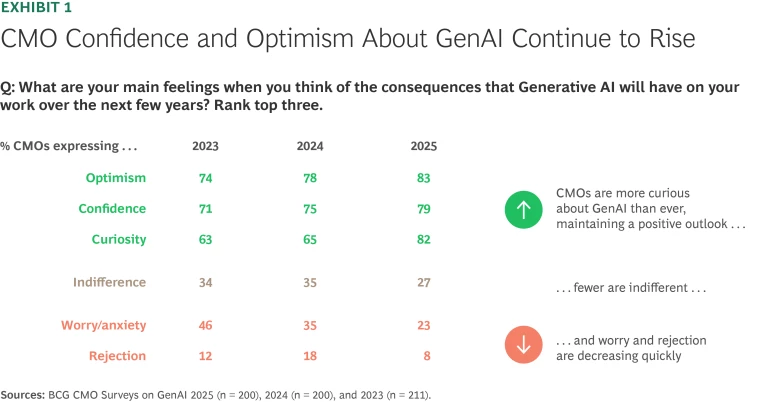
This optimism has fueled aggressive investments in ambitious business cases. A large majority of respondents (71%) plan to invest at least $10 million annually in GenAI over the next three years, up from 57% last year. The underlying business cases—mostly built in 2024 before the current economic volatility—assume the technology will help fuel significant revenue growth, with 60% of CMOs projecting incremental growth rates of 5% or more in their focus areas.
Around 80% of CMOs in this year’s survey expressed both optimism and confidence about GenAI.
Over a third of CMOs already report significant improvements in customer experience and content (both quality and volume) thanks to GenAI. But surprisingly, fewer respondents than last year reported significant efficiency gains from increased productivity and the elimination of manual work. This reflects the fact that reimagining end-to-end marketing workflows with GenAI tools requires more work than capturing efficiencies in individual steps. (See Exhibit 2.)
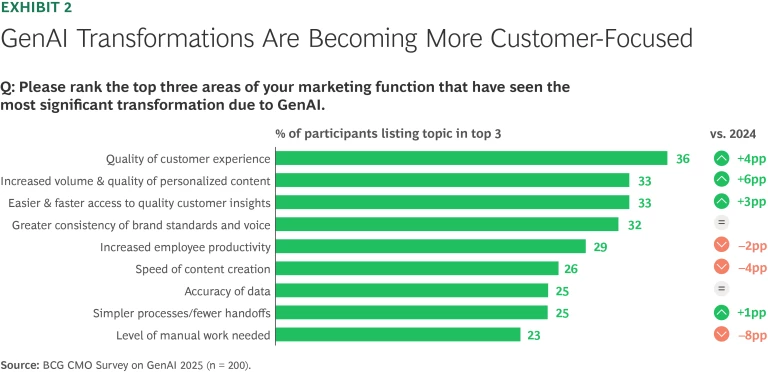
GenAI Is Now Directing the Content Show
After experimenting across many use cases in 2023, CMOs started to achieve significant scaling in the last 12 months. Exhibit 3 compares the percentage of survey participants who piloted GenAI use cases in 2023 with the percentage who reported achieving scale in 2024 and indicates where CMOs are prioritizing investments for 2025.
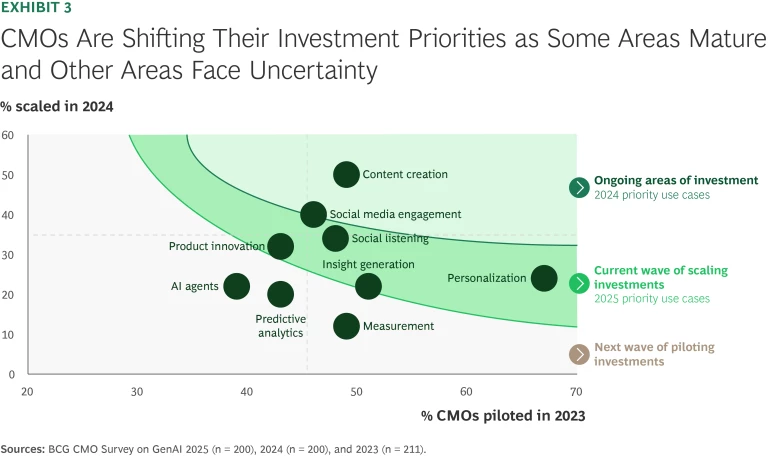
It is no surprise that the scaling of content creation—one of the original GenAI applications—stands out, as companies are already reaping the benefits of proven use cases in text and image generation. In recent months, we’ve seen a pronounced reallocation of resources toward more advanced applications.
New technology is rapidly making video generation the next frontier: companies are now experimenting with scenarios that only recently seemed futuristic.
New technology is rapidly making video generation the next frontier: companies are now experimenting with scenarios that only recently seemed futuristic. Around 30% of respondents identified immersive formats such as video generation as their next area of focus. (See Exhibit 4.) For example, at its latest Google Cloud Next conference, Google showcased how it used its AI tools—Veo 2, Imagen 3, and fine-tuned Gemini models—to enhance and expand the original 1939 version of the movie “The Wizard of Oz” for the Sphere in Las Vegas. The technology enables it to upscale resolution to fit 16K LED screens, expand original frames, and recreate scenes in new immersive backdrops while keeping original dialogue, characters, and music intact.
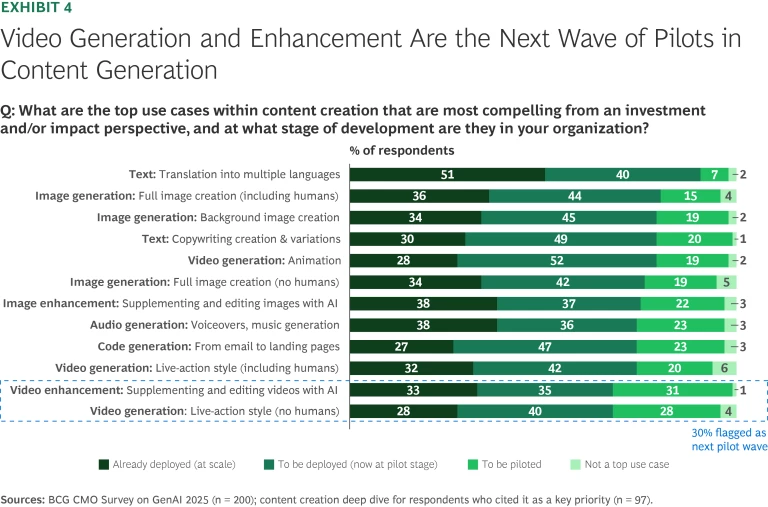
We have seen many marketing teams tap into the exciting possibilities for GenAI to quickly develop first-draft content, cut creative cycle times, and rapidly incorporate consumer feedback. By embedding GenAI tools further upstream in photoshoots, for example, teams get to a first draft faster and more efficiently and eliminate the need for reshoots. Meanwhile, the falling cost of immersive content now enables teams to bring high-quality storytelling down to level of micro-segments by tailoring the background, context, music, products, and even characters to fit the targeted audience. Without GenAI, the same alterations would be cost prohibitive.
How AI Powers Personalization and Insight Generation
Personalization is becoming a key lever as marketers balance efficiency and growth and CMOs continue to make it an investment priority. (See Exhibit 5.) They are widely deploying simple use cases where out-of-the-box tools enable accurate personalization. Many respondents cited product recommendations, the timing of personalized outreach, and next-best content as areas they have fully scaled. But in the current economic context, it will be increasingly important for CMOs to move from pilots to scale in the next tier of use cases, such as personalized offers, churn prediction, and audience optimization for campaigns.
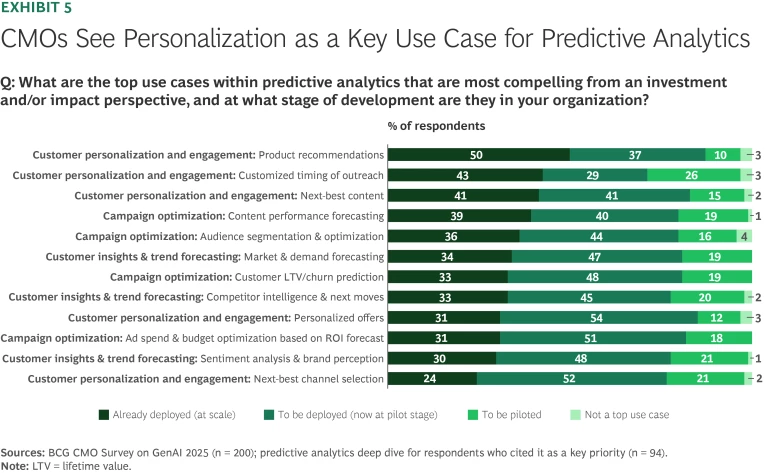
In one example, Tesco, the UK’s largest retail chain, enhanced its advanced loyalty program and data-driven marketing by revamping its Clubcard program. This now includes gamified challenges that reward customers with personalized discounts and prizes. The initiative makes full use of predictive AI for targeting customers based on their individual preferences as well as GenAI for creating a vast number of offer variants and associated content.
By combining GenAI’s power for content creation with the precision targeting enabled by predictive AI and multivariate experimentation, leading marketers are becoming better at orchestrating campaigns across multiple channels. They are adjusting their operating models and ways of working to break down silos across channel teams. By scaling personalized offers, they are also generating returns that are often three times as high as the typical returns from mass offers.
At the same time, GenAI is democratizing the generation of insights. Instead of relying on time-intensive and error-prone manual analyses, marketing teams can now use AI-powered assistants to instantly interrogate trends, campaign results, and customer behavior. Consumer packaged goods companies are using GenAI to generate initial campaign briefs and new product concepts. And a large entertainment company and a global fashion brand are using GenAI to spot trends early and then create personalized campaigns to amplify them at the microsegment level.
Stay ahead with BCG insights on marketing and sales
The Rise of Agentic AI in Marketing
Agentic AI has started to climb the GenAI investment agenda to become a growing priority, driven by B2B companies. (See Exhibit 6.)
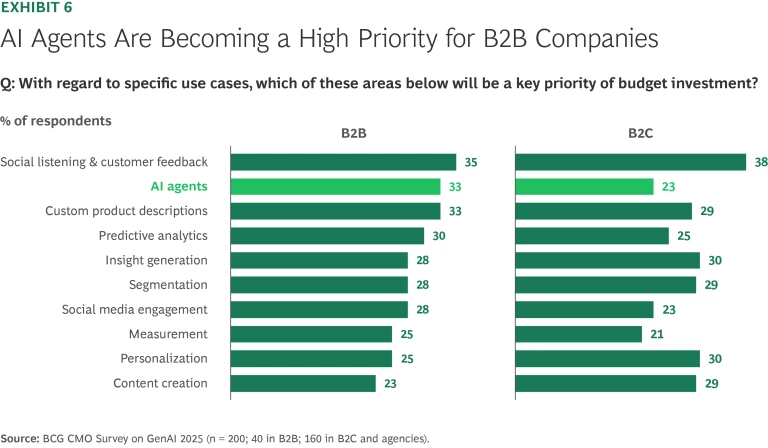
Across industries, we are seeing widespread application of AI agents to help marketers generate insights, draft campaign briefs, and automate key steps in content creation, quality assurance, and approvals. In B2B companies, marketing and sales teams are using agents for managing leads, assisting with customer support, and handling tasks such as returns and refunds. For 2025, we expect to see swarms of agents beginning to automate end-to-end campaign workflows. (See Exhibit 7.)
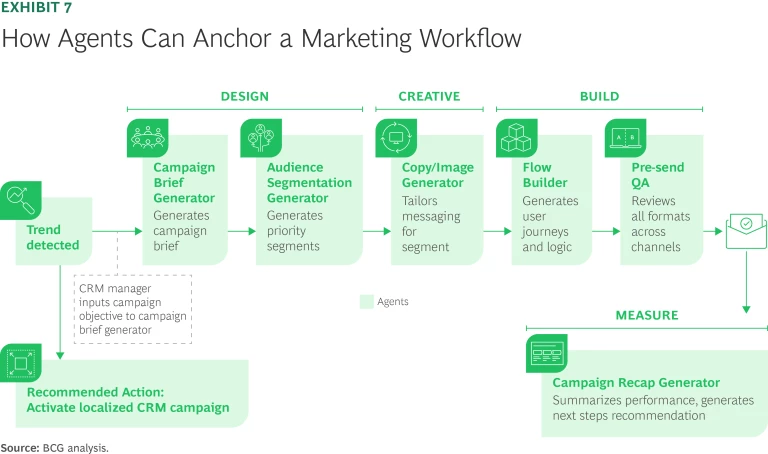
The next frontier is the innovation of customer-facing agents beyond simple e-commerce chatbots for shopping guidance. For example, Delta recently announced Delta Concierge, a digital assistant that will be embedded in the Fly Delta app. Designed to act as a personal travel companion, it will anticipate customers’ needs from airport arrival to their final destination, including multimodal coordination with partners like Uber, YouTube, and Joby. The tool aims to streamline the travel experience by offering timely, context-aware support at every stage of the journey.
For 2025, we expect to see swarms of agents beginning to automate end-to-end campaign workflows.
Similarly, L’Oréal has started to globally scale Beauty Genius, its AI- and GenAI-powered personal beauty assistant. Beauty Genius delivers individual, in-depth beauty diagnoses in real time. It also integrates augmented reality features that enable virtual try-ons, so consumers can use their devices to visualize how products will work for them, seamlessly blending personalization with interactive engagement.
Measurement Powers the GenAI Flywheel
Measurement involves more than tracking impact and measuring ROI—it is also a key enabler of scale, optimization, and accountability. In our 2025 survey, however, measurement ranked last when we asked CMOs about how they are prioritizing funds to improve the digital customer experience and the marketing tech stack that enables it. (See Exhibit 8.)
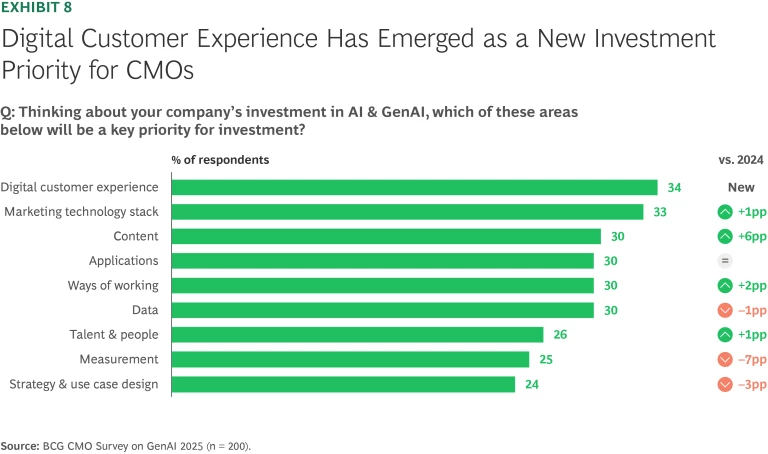
We attribute this lower prioritization in part to the successes that CMOs have had with measurement in previous years. Record investments in first-party data collection and the associated measurement have given some companies the necessary foundations. But the lower prioritization may also indicate a blind spot, because considerable untapped potential remains. And when it comes to measuring true marketing ROI, many companies are underinvesting, especially in the ability to link marketing to incremental sales, get an aligned view on harder-to-measure upper-funnel and nontraditional investments, and optimize personalized content for in-flight campaigns based on automated measurement.
We recommend that marketers invest to shore up measurement fidelity in light of volatile market demand and economic uncertainty. A strong partnership between the CMO and CFO is more important than ever to ensure the right level of investment in high-return uses of GenAI.
In 2025, two areas of sustained investment are talent development and tools that enable agile ways of working and upskilling teams. CMOs are realizing that hiring GenAI talent in sufficient volume is not an option. This makes the training of existing teams an imperative.
To give their teams exposure to new tools, forward-thinking CMOs are deploying a range of creative options, including hackathons where teams try out the most recent solutions from startups and established tech vendors. They are also launching AI incubator studios where marketers work on solving a specific challenge to test the power of the latest GenAI apps, such as creating many personalized versions of an upcoming campaign. They are bringing in outside experts as well as tech and agency partners to demo and explain tools to their teams. Finally, they are working with their IT and business teams to move from blanket bans on GenAI tools to an approach in which clear guardrails guide what they can pilot and what they can use at scale. These guardrails include well-documented policies around responsible use and how to address emerging questions. (See Exhibit 9.)
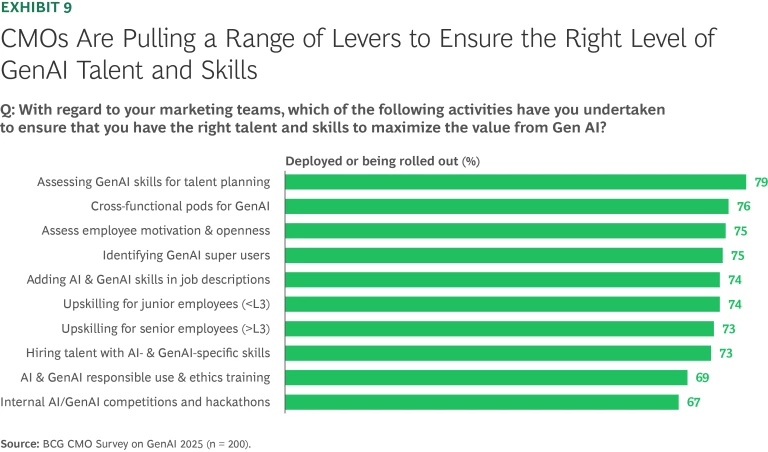
As budgets come under pressure in 2025 and companies scrutinize investments, forward-thinking CMOs will build on their strong measurement foundations and carefully prioritize investments. Key areas include pushing the frontiers of content generation, personalization, and insights, arming their marketers with AI agents, and upskilling them on the new technologies.






